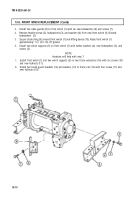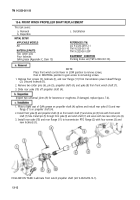TM-9-2320-361-20 - Page 969 of 1207
TM 9-2320-361-20
13-4. AUTOMATIC BRAKE TEST AND ADJUSTMENT
This task covers:
a. Testing
b. Adjustment
INITIAL SETUP:
APPLICABLE MODELS
EQUIPMENT CONDITION
All
Parking brake set (TM 9-2320-361-10).
PERSONNEL REQUIRED
GENERAL SAFETY INSTRUCTIONS
Two
Wear leather gloves when handling winch cable.
REFERENCES (TM)
Never stand between test vehicles during winching
procedures.
TM 9-2320-361-10
Assistant must remain in secondary vehicle.
Use hand throttle to control engine speed when
operating winch.
NOTE
Procedures for front winch and rear winch (M756A2) automatic
brake adjustment are the same. This procedure covers the front
winch testing and adjustment only.
1. Park test vehicle (1) at top of steep grade facing downhill and chock wheels (refer to
TM 9-2320-361-10).
2. Park secondary vehicle (2) at bottom of steep grade facing test vehicle (l).
WARNING
3.
4.
•Wear leather gloves when handling cable. Do not let cable run
through hands. Broken or rusty wires can cause injury to personnel.
•Never stand between test vehicles. Assistant must remain in
secondary vehicle to engage service brake if cable snaps or
automatic brake fails. Failure to do this may result in injury to
personnel.
CAUTION
Do not use front winch to pay out line loads greater than 3,000 lb
(1,362 kg) for any distance greater than 10 ft (3. 1 m). Damage to
equipment may result.
Pull out drum lock lever (4) and turn 90° clockwise to unlocked position. Unwind cable (5) and rig to
secondary vehicle (2).
Place secondary vehicle’s (2) transmission lever in neutral position. Disengage parking brake and
disengage front wheel drive lever if engaged.
WARNING
Never stand between test vehicles. Assistant must remain in
secondary vehicle to engage service brake if cable snaps or
automatic brake fails. Failure to do this may result in injury to
personnel.
Refer to TM 9-2320-361-10 for safe working loads.
5. Place winch drum clutch lever (3) in ENGAGE position.
13-4
Back to Top




















